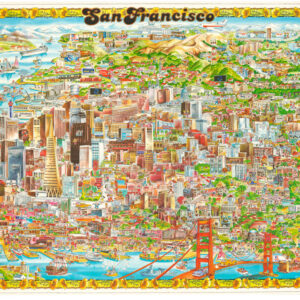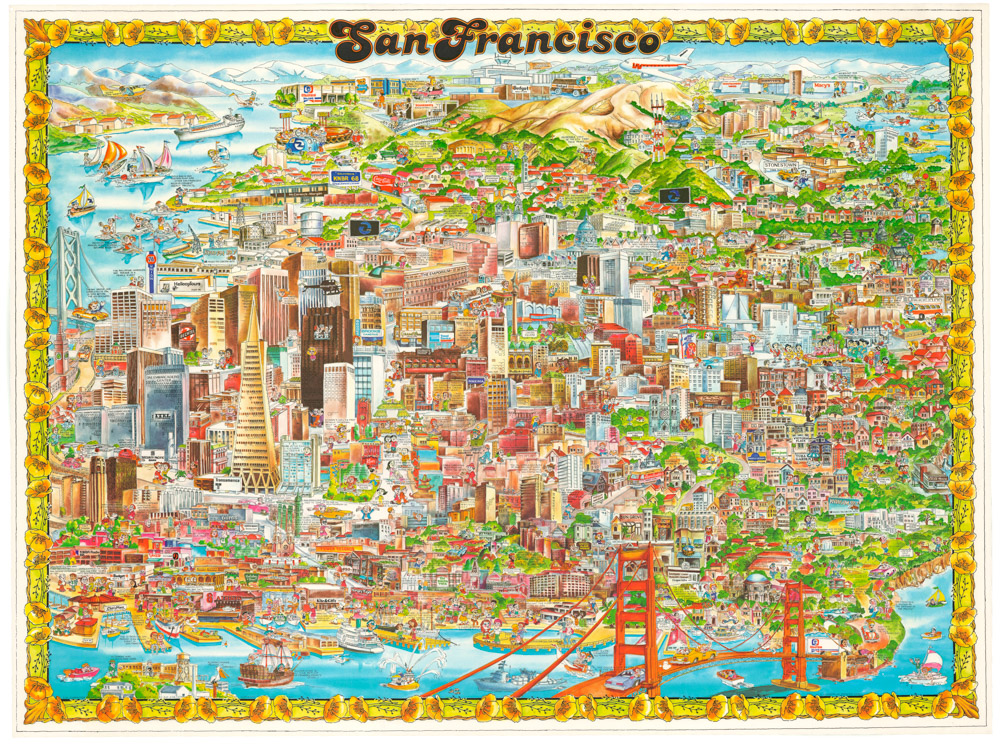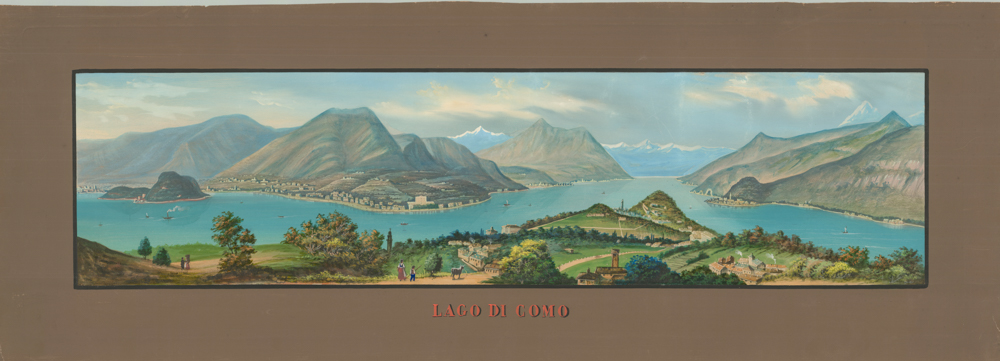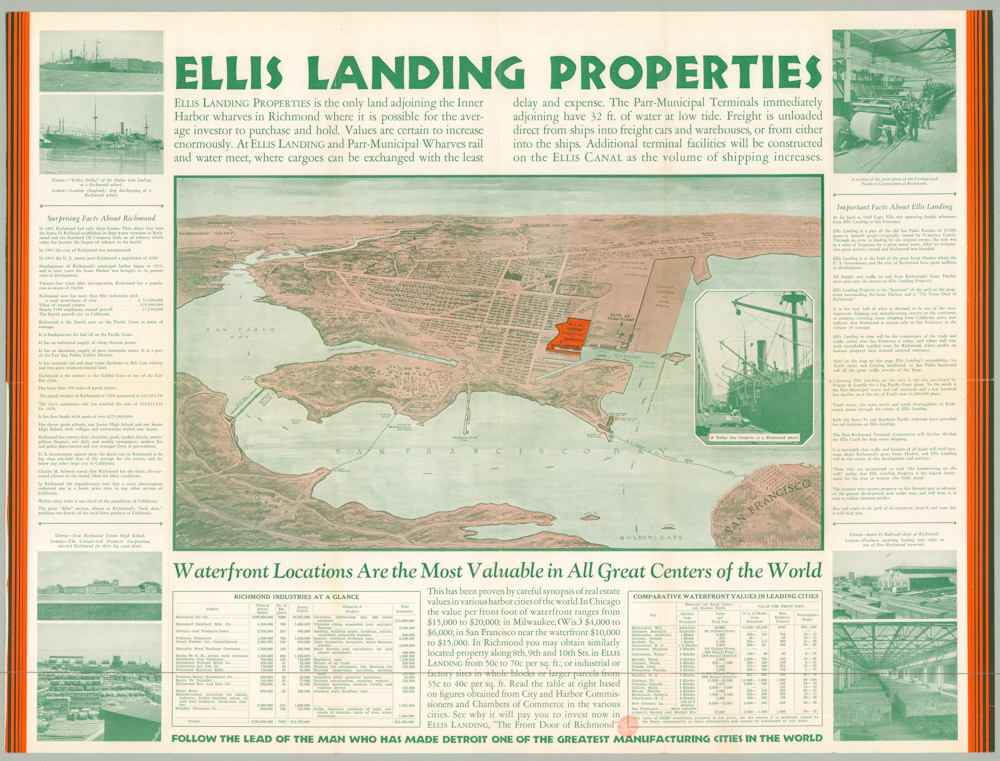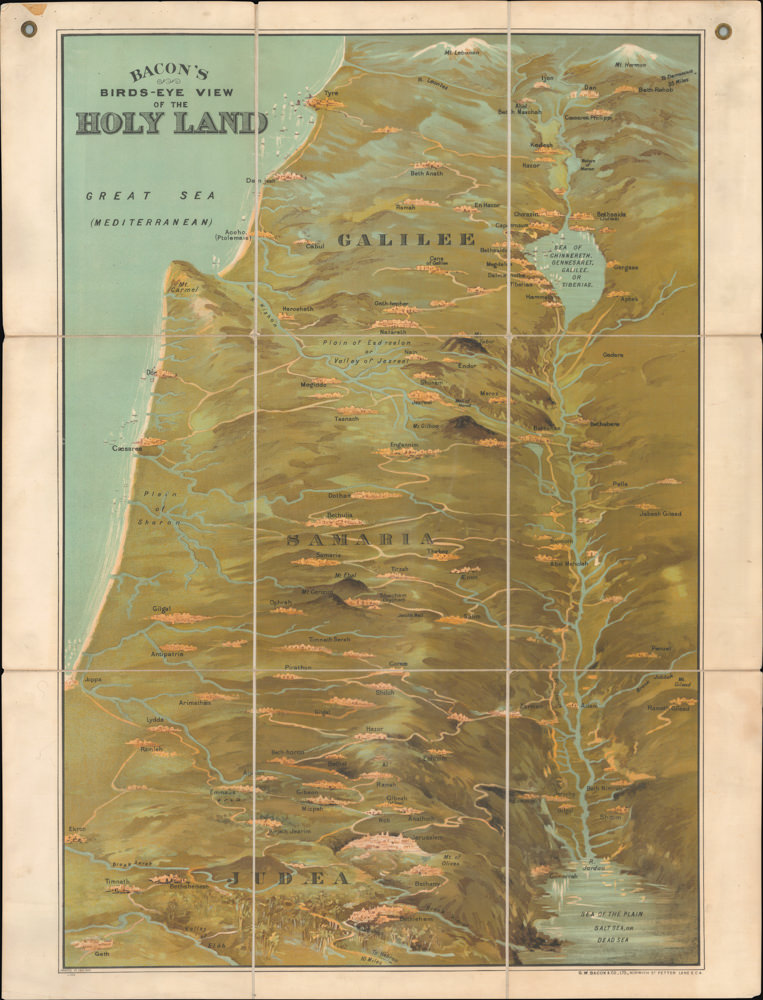Two of the earliest obtainable views of Singapore.
[Pair of views] Rade et Ville de Sincapour & Rade de Sincapour prise de la maison du Gouverneur
$7,000
1 in stock
Description
In 1846, Parisian artist Étienne Eugène Cicéri produced some of the earliest obtainable views of the historical port of Singapore. His stunning etchings were adapted from original maps and sketches that he had compiled while on Jules Sébastien César Dumont d’Urville’s (1790-1842) great voyage to circumnavigate the globe. D’Urville’s Third Expedition sailed from Toulon, France, in 1837 and had set as one of its goals to advance as far south as possible with the aim of claiming the South Pole for France. In the South Atlantic, the expedition reached Antarctica and mapped important coastal stretches before again proceeding north along the Chilean coast and across the Pacific towards Oceania. Managing to cross the ocean and sailing on a number of Pacific islands during the course of the following year, d’Urville’s ships Astrolabe and Zellee reached Singapore in late June of 1839. From June 27th until July 2nd the crew remained there, and it was during these restful days that Cicéri drew his famous views of the city.
Upon completion of the expedition, the views were converted to engravings by the Thierry Frères publishing house in Paris and prepared for publication by Gide. The views were included in the Atlas Pittoresque of d’Urville’s formal publication Voyage au pole sud et dans l’Océanie sur les corvettes l’Astrolabe et la Zélée. Both the atlas volume (Atlas Pittoresque) in which these engravings are found, as well as the individual engravings of these early views themselves, are extremely scarce. We have identified institutional examples at the National Library of Australia and the Library Board of Singapore. We are unaware of any of Cicéri’s views currently on the open market.
View #1: Rade et Ville de Sincapour (Malaisie).
In this particular image we are provided with a stunning vista of the old city. Looking south from Government Hill (Fort Canning Park), the densely built-up port stretches out in the background. Running through most of the image is the great Sungei Sincapura or Singapore River, which to this day widens at its mouth and empties into the city’s marina. Sprawled out beneath us we see the famous commercial harbor flanked on the right by the Chinese Campong (Singapore’s Chinatown). In the bay beyond, a substantial number of large merchant ships are anchored.
Government Hill was the site of the original Malay town of Temasek, which was founded in the late 13th century as a trading port. From the 17th century, it was the Portuguese and Dutch who dominated these waters, but as their influence waned, the British presence grew ever stronger. In 1819, the new British governor, Stamford Raffles, noted the island’s ideal placement and topography for a major trading port, and within five years he had negotiated a treaty with the Sultan of Johor that first allowed the British to establish a trade colony here, but which soon meant that ownership of the entire island was passed to the Crown. Raffles immediately began building up the new settlement, expanding on the small existing community of Malay and Chinese traders, and allocating the lands west of the river to serve as a Chinese community or campong.
During the 1830s and 1840s, the entire area underwent rapid development and growth. Business boomed as a result of the growing trade and with the expanding physical scope of the Campong, there was room for both newcomers and established clans to thrive. In general, Singapore’s growth under Raffles was explosive: when he first arrived, an estimated 1000 people inhabited the island, but within three decades the population had grown to more than 80,000 people, around half of which were Chinese traders and their families.
Cicéri’s renditions are especially important because of their timing. Arriving in 1839, d’Urville’s crew witnessed Singapore at the end of its first major period of growth, and as such in its initial transition from pre-industrial to early modern port. Cecéri’s vista catches the city in the middle of this remarkable process. Among the iconic buildings from this formative period in Singapore’s history, we recognize the large courthouse near the waterfront, with its salient front and tall tower capped by an oriental looking dome. Roughly in the center of the view is the wooden Jackson Bridge crossing the river (replaced in the 1920s by present-day Elgin Bridge). This leads to a large commercial enclosure known as Edward Boustead’s Godown (Indian term for warehouse). Boustead (1800-1888) was an English businessman and philanthropist, who founded the Singapore trading house Boustead & Co. He was a close partner to Raffles and played an active role in the development of Singapore as a center of business and trade in the region.
Also visible down by the mouth of the river is the impressive Fort Fullerton, which was built on Battery Point in 1829 and named after Lord Robert Fullerton, the first British governor of the the newly created Straits Settlement (1826-30). The fort housed the military administration, its officers, as well as barracks for the garrison of artillery-men stationed here upon its completion. Over the coming decades, it was Fort Fullerton that constituted the physical framework that allowed Singapore to become one of the most well-defended British colonies in the world. Most of this transformation was still to come at the time these views were drawn, but the foundations for Singapore’s impressive development had clearly been established. In this way, Cicéri’s images provide us with a sense of great things to come.
A final note should be made on a group engaged in heavy discussion in the foreground of the image on Government Hill. Scattered about them we see plates, water jugs, and carpets to sit and/or pray on. Cicéri has most likely included them to imbue his sketch with vitality and some of the exotic atmosphere that characterized this city. While it is difficult to ascertain the exact cultural origins of the group in question, we do note that it seems to consist exclusively of men. The men are dressed in long robes and in most cases wear turbans or other wrapped head gear. Many of them are smoking the type of long pipes for which the Ottomans were famous, though this need not imply any direct connection in that regard. While it is hard to identify the background of the figures more specifically, they are most likely Malay Muslims, although in light of Singapore’s cosmopolitan nature, they could also be visitors from others parts of the Islamic world.
View #2: Rade de Sincapour prise de la maison du Gouverneur (Malaisie).
This image shows the eastward view from Government Hill (Fort Canning Park) towards the early town and harbor of Singapore. A notable feature of this panorama are the dense rooftops of the Chinese Campong (Singapore’s Chinatown). Separating the vantage point from the city itself is the large Singapore River, which widens significantly as it approaches its mouth. In our view, it cuts across the image, flowing from right to left towards the harbor, where it empties to this day. In the left fringe of the image, we see Jackson Bridge crossing the river into the city, connecting the eastern and western sides of the harbor.
When Stamford Raffles laid out the plan for Singapore in 1822, known as the Master Plan, he allocated the lands west of the Singapore River to serve the Chinese community — known as the Campong (Kampong). The area was highly desirable for its good access to the port and room to expand. Raffles was of course interested in the massive amount of trade that Chinese merchants brought to the city, but he also recognized that, in time, the Chinese would comprise the bulk of Singapore’s population.
At first, the Chinese immigrants subdivided the Campong according to dialect and provincial origin, but soon these blended together to form a patchwork of Chinese identities, cultures, and languages. During the 1830s and 1840s, the Campong underwent a period of impressive growth and development. While business boomed as a result of the growing trade, the infrastructure was also improved by laying out new thoroughfares and creating new access points to the harbor. With the expanding physical scope of the Campong, there was room for both newcomers and the established Chinese clans to thrive, making it one of the most dynamic diaspora communities in the world. Today, Singapore’s Chinatown continues to be one the city’s most crowded and vibrant neighborhoods.
Among the landmarks depicted within the Campong, most prominent is the bi-level hipped roof of the Thian Hock Keng Temple (天福宮). This distinct building was dedicated to Mazu, a Chinese sea goddess, emphasizing both the important Chinese presence in the city, as well as this community’s distinctly maritime outlook. Its inclusion in Cicéri’s sketch is in many way serendipitous, as historical records show that the temple was still under construction when d’Urville’s expedition visited. Yet its prominence on the skyline also denotes that we are in the late stages of the first great construction boom that Singapore witnessed in the 19th century. Swampy wetlands separate the Campong from the older village houses along the river. The open waters in front of the city are teeming with anchored ships, underlining that by the time of d’Urville and Cicéri’s visit in 1839, Singapore was already a major trade hub in Southeast Asia.
D’Urville’s Third Expedition (1837-1840)
Jules Sébastien César Dumont d’Urville’s (1790-1842) was an avid French explorer and Navy captain, who mounted three major expeditions in his career and who sailed extensively on the South and West Pacific archipelagos, Australia, New Zealand, and Antarctica. In addition to exploring and mapping somer of the still unknown reaches of our planet, his tireless efforts lead to new discoveries in a range of fields — including botany, zoology, cartography, ethnography and linguistics.
D’Urville was trained as a naval officer in Napoleon’s navy, an institution that was not as revered or funded as his army. In his early years, d’Urville spent most of his training learning languages and gaining proficiency in everything from Chinese to English to ancient Hebrew. This would be an important skill, which in the Pacific would allow him to pick up languages much faster than any of his officers. Following the final exile of Napoleon in 1815, d’Urville joined several naval expeditions to the Mediterranean. It was on one of these trips that he came across a local Greek peasant on the island of Milos who had unearthed a large ancient statue, which d’Urville immediately recognized as important, and which he after some wheeling and dealing managed to secure for the French state. Today, this statue, known as Venus of Milo, stands in the Louvre and constitutes one of, if not the most famous sculpture from Antiquity. After his Mediterranean expeditions, d’Urville began planning a major voyage to the Pacific; an area of considerable French interest despite the limited capacity of her Navy, but also one which had been largely lost during the Napoleonic Wars.
In August of 1822, the expedition set sail from Toulon on the proud vessel Coquille. Even though d’Urville was the expedition’s primogenitor, command rested with Louis Isidore Duperrey, a friend and colleague of d’Urville who was four years his senior. The purpose of the expedition was primarily to gather as much scientific information as possible, as this would help the French to reassert their territorial claims in the region. For this purpose, the expedition also brought a French naturalist, René-Primèverre Lesson, and in unison d’Urville and Lesson made a long list of scientific discoveries and brought home specimens of thousands of animals and plants. Among the more notable discoveries from this expedition was the discovery of a new species of penguin, which d’Urville named Adelie after his wife.
The amicable relationship between d’Urville and his commanding officer Duperrey became increasingly strained, and the expedition was hardly back before d’Urville began lobbying parliament to mount a new expedition, this time with him in charge. The Coquille was renamed the Astrolabe, in honor of La Perouse’s lost expedition to the same area, and they set sail from French naval HQ at Toulon in 1826. While the first expedition had surveyed the Falklands and sailed up the Chilean and Peruvian coasts, this voyage concentrated more on Australasia and Oceania, with island communities such as New Zealand, Fiji, New Caledonia, Solomon Islands and the Moluccas being just some of the places they visited. Among the many important results was d’Urville’s recognition of distinct cultural and linguistic clusters in the Pacific Islands, and upon his return it was he who coined the different terms still in use today (e.g. Micronesia, Melanesia, and Polynesia).
Upon their return to France, d’Urville was commissioned with the assignment of compiling the final report of their journey, a task which he accomplished in a few years and which was published in 1834. However, d’Urville’s life at sea had caused him significant health problems, including kidney and stomach problems, and severe cases of gout. His ill health, and the loss of at least three children to disease, gave d’Urville a less than pleasant disposition. He was unsatisfied with the recognition that his voyage with the Astrolabe had given him, and blamed the French establishment for his woes.
D’Urville’s increasingly critical and difficult disposition aligned well with the fact that he had been canvassing for a third voyage since shortly after his return from the Second Voyage. D’Urville had studied the results from his expedition carefully and had found gaping holes in their knowledge — especially in regard to southern latitudes. He no doubt entertained hopes of reaching the same fame as his English counterpart, Captain James Cook, and in many ways saw his third voyage as analogous to Cook’s famous third expedition. The French king, Louis-Phillipe, was also keen to mount a French voyage of discovery that in scale and scope of achievement could rival that of James Cook, especially in the Antarctic.
Consequently, the king made it d’Urville’s primary mission to identify magnetic South Pole and claim it for France. If this proved impossible, he was to place the French flag as far south as possible by entering the Weddell Sea, one of two large open bays in western Antarctica. Obviously, this was a dangerous mission. Even in summer, the ice flows could be deadly and catch a ship unexpectedly. The crew was therefore promised a bonus of 100 francs each if 75° South was attained. The expedition crossed the Antarctic Convergence on January 16, 1840 and two days later found themselves in the middle of an icy sea. Pressing on, they hoisted the Tricolor at Cape Géodésie and the voyage hydrographer, Clément Adrien Vincendon-Dumoulin (1811 – 1858), prepared an impressively accurate map of the promotors visible coastline.
The Third Voyage of d’Urville included two ships. In addition to the Astrolabe, which sailed under d’Urville’s command, there was the Zélée, which was commanded by Charles Jacquinot. The ships set out from Toulon in September of 1837, and while the geographical goal of this mission was clear from the start, this expedition would end up circumnavigating the entire globe — a feat only accomplished by a handful of expeditions at this point in history. Along the way they visited New Zealand, Singapore, Australia, Chile, Brazil, Tenerife, the Cape of Good Hope, and many other places. It was a result of this voyage that d’Urville’s team visited Singapore in 1839 and Cecéri produced his wonderful vistas, which today have become great rarities.
Back in France, d’Urville was celebrated for his accomplishments and soon promoted to rear-admiral. He was also awarded the gold medal of the Société de Géographie, the highest honor that they could bestow upon an explorer. Two years after his return to France, Dumont d’Urville and his family were killed in a tragic train derailment — the first in French history — on their way from Versailles to Paris.
**Offered jointly with Geographicus Rare Antique Maps (Brooklyn, NY)**
Cartographer(s):
Étienne Eugène Cicéri (January 27, 1813 – April 20, 1890) was a French painter, illustrator, engraver, and theater designer who was active in the middle part of the 19th century. Cicéri was born in Paris, the son and pupil of the painter and scenographer Pierre-Luc-Charles Cicéri (1782 – 1868). His instruction in art began as a child under his father and uncle, Eugène Isabey (1803 – 1886). Influenced by the Barbizon School of landscape art, he rose to prominence as a landscape painter and watercolorist, working at Fontainebleau, the Alps, and the Pyrenees. He exhibited at the Paris Salon for the first time in 1851 and continued to exhibit until at least 1886. He also issued North African landscapes and painted scenes to illustrate the travels of Jules Sébastien César Dumont d’Urville’s (1790 – 1842) circumnavigation.
Thierry FrèresThierry Frères (c. 1827 – 1865) was a Paris-based lithography house which was active in the mid-19th century and started at Cité Bergère No 1 à Paris. The firm is generally considered to be the successor to Engelmann et Cie and was superbly skillful and prolific, being among the dominant fine-art lithography houses in Paris, despite the fact that the firm’s operations — and even the full names of its founders — are shrouded in obscurity.
Condition Description
Both in very good condition with clean, wide margins.
References
Source: D'Urville, J. D. and Vincendon-Dumoulin, C. A. , Vincendon-Dumoulin, Voyage au Pôle Sud et dans l'Océanie sur les corvettes L'Astrolabe et La Zélée exécuté par ordre du Roi Pendant les Années 1837-1838-1839-1840 sous le commandement de M. Dumont-d'Urville. Atlas pittoresque. (Paris: Gide) 1846.
